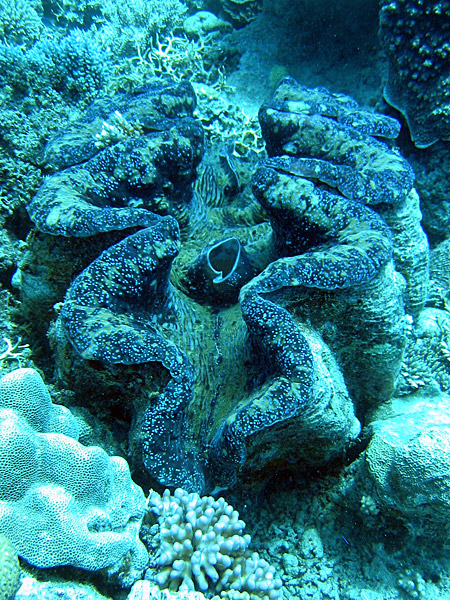- Giant clam
:"In
Japanese cuisine ,Geoduck (mirugai) is sometimes referred to as "giant clam"."Taxobox
name = Giant clam
status = VU
status_system = iucn2.3

image_width = 250px
regnum =Animal ia
phylum =Mollusca
classis =Bivalvia
ordo =Veneroida
familia =Tridacnidae
genus = "Tridacna "
species = "T. gigas"
binomial = "Tridacna gigas"
binomial_authority = Linnaeus,1758 The giant clam, "Tridacna gigas", or traditionally, pa’ua, is the largest living
bivalve mollusc . One of a number of largeclam species native to the shallowcoral reefs of the South Pacific andIndian ocean s, they can weigh more than 200 kilograms (440 pounds), measure as much as 1.2 metres (4 feet) across, and have an average lifespan in the wild of 100 years or more. [cite web
url=http://www3.nationalgeographic.com/animals/invertebrates/giant-clam.html
title=Giant Clam: Tridacna gigas
Publisher=National Geographis Society
accessdate=2007-06-02] They are also found off the shores of the Philippines.Fact|date=August 2008Sessile in adulthood, the creature's mantle tissues act as a habitat for thesymbiotic single-celleddinoflagellate algae (zooxanthella e) from which it gets its nutrition. By day, the clam spreads out its mantle tissue so that the algae receive thesunlight they need to photosynthesize.History and Legend
As is often the case with uncharacteristically large species, the giant clam has been historically misunderstood. Known in times past as the "killer clam" or "man-eating clam", reputable scientific and technical manuals once claimed that the great mollusc had caused deaths; versions of the "
U.S. Navy Diving Manual " even gave detailed instructions for releasing oneself from its grasp by severing the adductor muscles used to close its shell.In a colorful account [ [http://www.pearlforpeace.org/cobb.html Accounts by Wilburn Dowell Cobb] ] of the discovery of the
Pearl of Lao Tzu , Wilburn Cobb said he was told that a Dyak diver was drowned when the "Tridacna" closed its shell on his arm.Today the giant clam is considered neither aggressive nor particularly dangerous. While it is certainly theoretically capable of holding one fast in its grip, in reality the shell's closing action is a defensive response, not an aggressive one, and the process of closing the shell valves is slow, far too slow to pose a serious threat. In other words, the clam is incapable of suddenly snapping shut on a person's arm or leg and thus drowning them.
Conservation status
The
IUCN lists the giant clams as vulnerable. There is concern amongconservationist s for the sustainability of practices among those who use the animal as a source of livelihood. The numbers in the wild have been greatly reduced by extensive overharvesting for food and the aquarium trade. On theblack market , giant clam shells are sold as decorative accoutrements, and the meat, called "Himejako" inJapan , is prized as a delicacy.Aquaculture
Recent developments in
aquaculture , specifically atHarbor Branch Oceanographic Institute inFt. Pierce, Florida and in theMarshall Islands , are allowing "T. gigas" to be tank raised for both use in homeaquariums and release into the wild.ee also
*
Platyceramus , the largest bivalve in the fossil recordReferences
External links
* Listed as Vulnerable (VU A2cd v2.3)
* ARKive - [http://www.arkive.org/species/GES/invertebrates_marine/Tridacna_gigas/ images and movies of the giant clam "(Tridacna gigas)"]
* "Tridacna gigas" entry on [http://animaldiversity.ummz.umich.edu/site/accounts/information/Tridacna_gigas.html Animal Diversity Web]
* Giant clam entry on the [http://www.iucnredlist.org/search/details.php?species=22137 IUCN Red List of threatened species]
* [http://www.usm.my/cemacs/Webpg%20Mariculture%20Research.htm Giant clam conservation research project] at Universiti sains Maylaysia
* [http://www.richard-seaman.com/Underwater/Australia/GiantClams/ Giant Clams of the Great Barrier Reef]
* [http://www.stanford.edu/group/microdocs/ Microdocs] : [http://www.stanford.edu/group/microdocs/solarclams.html The solar powered clam]
Wikimedia Foundation. 2010.
